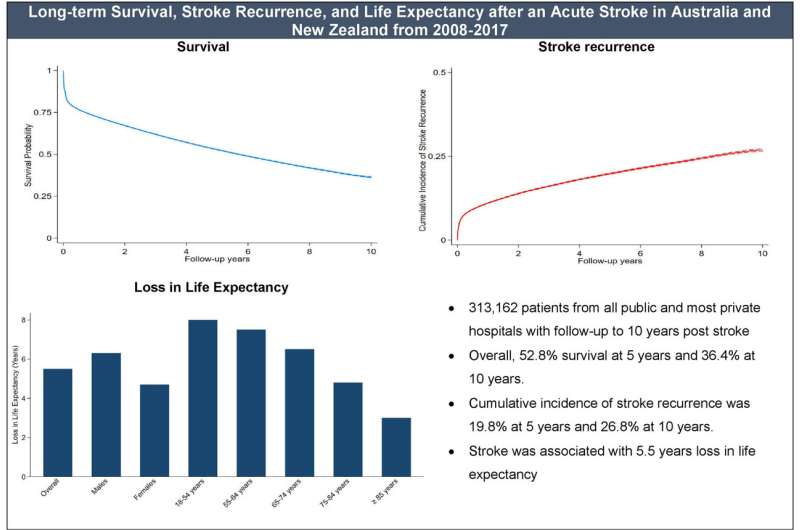Stroke cuts life expectancy by one third

Almost two thirds of acute stroke patients fail to survive more than a decade and have high risk of recurrence, prompting researchers to call for better patient care.
University of Queensland researchers analyzed data from more than 300,000 patients admitted to hospital following a sudden stroke between 2008 and 2017 in Australia and New Zealand.
The team also investigated how many years were lost to stroke by comparing a patient's predicted life expectancy with the length of actual survival.
Study leader and UQ epidemiologist, Dr. Yang Peng, a Research Fellow with the Prince Charles Hospital Northside Clinical Unit, said only 36.4% of patients survived beyond 10 years, and 26.8% had another stroke.
"We found that a stroke reduced a patient's life expectancy by five and a half years on average, compared with the general population," Dr. Peng said.
"In proportional terms, this meant a stroke reduced a person's life expectancy by one third.
"Patients with a hemorrhagic stroke who have bleeding in the brain are at greater risk of death, another stroke and reduced life expectancy, than those with an ischemic stroke, which is caused by a burst blood vessel."
Acute stroke is one of the most common causes of hospitalization and disability in Australia and has been linked to risk factors such as high blood pressure, elevated cholesterol levels, diabetes, smoking and heart disease by the Stroke Foundation.
Study co-author, Dr. Kathryn Colebourne, a stroke and general physician at The Prince Charles Hospital, said these findings reinforce the need for concerted efforts to improve acute stroke care.
"We need stroke networks of care to rapidly identify patients who have had a stroke, provide them with access to important and time-sensitive treatment, such as thrombolysis, a clot busting medication, and endovascular therapy, a specialized procedure to remove blood clots in the vessels to the brain," Dr. Colebourne said.
"We also need dedicated stroke units to provide multidisciplinary care for these patients which is known to reduce death and disability after a stroke."
Dr. Peng said there should also be a focus on lifestyle and risk factor modifications for secondary prevention, given the number of patients who will have a recurrent stroke.
"Very few population studies have explored the long-term outcomes of stroke," he said.
"This information is crucial for patients to understand their prognosis, and for health professionals seeking to improve stroke care and preventative measures."
This study is published in Stroke.
More information: Yang Peng et al, Long-Term Survival, Stroke Recurrence, and Life Expectancy After an Acute Stroke in Australia and New Zealand From 2008–2017: A Population-Wide Cohort Study, Stroke (2022). DOI: 10.1161/STROKEAHA.121.038155




















